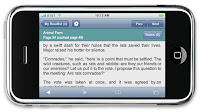The latest symposium on popular media audiences has a good set of speakers; not surprisingly it's in England:
The Centre for Cultural and Creative Research at the University of Portsmouth presents:
Popular Media Cultures: Writing in the Margins and Reading Between the Lines
A Symposium to be held at the Odeon Cinema, Covent Garden, London
Saturday 19th May 2012
Keynote Address by:
Prof. Henry Jenkins
Provost’s Professor of Communication, Journalism and Cinematic Arts, University of Southern California. Author of Textual Poachers (Routledge, 1992), The WOW Climax (NYU Press, 2006), Fans, Bloggers and Gamers (NYU Press, 2006), and Convergence Culture (NYU Press, 2006).
Focus:
The first steps toward a wider consideration of popular media cultures surrounding film, television and the Internet, and the relationship between fans and their object of fandom, is to acknowledge the prominent position of what Jonathan Gray calls media paratexts as opposed to the centrality of specific films or television series as the text. Indeed, we are now accustomed in fan studies to state that the productivity of fans and their related fan practices represent an appropriate and worthy text to study just as much as the media text to which they are related or inspired by. So, rather than studying Star Trek as cult text, we might study fan produced videos on YouTube as important texts of fan activity that carry inherent meaning and significance in and of themselves. Or, for example, Star Wars carries with it meaning within and outside the narrative – from an analysis of its mythic story structure using the work of Joseph Campbell to studies of its fans who actively engage in their own meaning making by dressing up, making videos and writing fan fiction. However, the peripheral texts – those associated with the commercialization of the franchise such as the lunchboxes, toys, video games, and websites – are as much part of the meaning making process that they become texts to study in their own right.
Popular Media Cultures seeks to explore the relationship between audiences and media texts, their paratexts and interconnected ephemera, and the related cultural practices that add to and expand the narrative worlds with which fans engage. How audiences make meaning out of established media texts will be discussed in connection with the new texts produced by fans. The symposium will focus on the cultural work done by media audiences, how they engage with new technologies and how convergence culture impacts on the strategies and activities of popular media fans. If, Ken Gelder argues, “Subcultures are brought into being through narration and narrative: told by the participants themselves, as well as by those who document them, monitor them, ‘label’ them, outlaw them, and so on,” then this symposium will pay attention to what media audiences add to a text, what gets written in the margins of a text and what new meanings fans read between the lines. This symposium will bring together leading academics in the fields of film, television, fan and cultural studies to open up and take further the debates surrounding popular media, its producers, its audiences, and the cultures in which they are ultimately located.
Confirmed Speakers:
Dr Stacey Abbott, Reader in Film Studies, Roehampton University. Author of Celluloid Vampires (University of Texas Press, 2007), editor of The Cult TV Book (IB Tauris, 2010), co-author of Falling in Love Again (IB Tauris, 2009), and series editor of Investigating Cult TV for IB Tauris.
Dr Will Brooker, Reader and Director of Research, Kingston University. Author of Using the Force (Continuum, 2002), Hunting the Dark Knight (IB Tauris, 2012) and editor of The Blade Runner Experience (Wallflower, 2005).
Dr Joanne Garde-Hansen, Principal Lecturer in Media and Director of the Research Centre of Media, Memory and Community, University of Gloucestershire. Author of Media and Memory (Edinburgh UP, 2011), co-editor of Save As... Digital Memories (Palgrave, 2009) and co-author of the forthcoming Emotion Online: Theorising Affect on the Internet (Palgrave).
Dr Kristyn Gorton, Senior Lecturer in Television Studies, University of York. Author of Media Audiences (Edinburgh UP, 2009) and co-author of the forthcoming Emotion Online: Theorising Affect on the Internet (Palgrave).
Dr Matt Hills, Reader in Media and Cultural Studies, Cardiff University. Author of Fan Cultures (Routledge, 2002), The Pleasures of Horror (Continuum, 2005) and Triumph of a Time Lord (IB Tauris, 2010).
Prof. Mark Jancovich, Professor of Film and Television, University of East Anglia. Author of Rational Fears (MUP, 1996) and The Place of the Audience (BFI, 2003) and co-editor of Defining Cult Movies (MUP, 2003), Quality Popular Television (BFI, 2003), and Film and Comic Books (Mississippi UP,
2007).
Prof. Roberta E. Pearson, Professor of Film and Television, University of Nottingham. Author of Eloquent Gestures (University of California Press, 1992), co-editor of Cult Television (University of Minnesota Press, 2004), The Many Lives of Batman (Routledge, 1991), and editor of Reading Lost (IB
Tauris, 2009).
Further details of how to register and attend the event will be published in the New Year. For information on the Centre for Cultural and Creative Research at the University of Portsmouth please visit our website at:
http://www.port.ac.uk/research/cccr/
Symposium Coordinator:
Dr Lincoln Geraghty
Director of the Centre for Cultural and Creative Research
School of Creative Arts, Film and Media
University of Portsmouth































